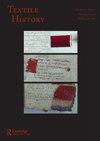“解放:富有远见的女性收集纺织品”,Two Temple Place,英国伦敦,2020年1月25日至4月19日
IF 0.1
2区 社会学
0 HUMANITIES, MULTIDISCIPLINARY
引用次数: 0
摘要
传统,抵制西方的快时尚概念,同时又完全是现代的(图4)《和服:京都到猫步》清楚地表明了和服研究的深度和丰富性。虽然和服通常被理解为一种被时间冻结的传统服装,但此次展览展示了和服同时也是传统的,与当代日本社会完全相关。虽然和服的基本结构在几个世纪以来一直保持不变,但展览表明,和服的风格、趋势、穿着方式及其含义都发生了巨大变化。和服的装饰图案可能参考诗歌或文学,也可能以视觉双关语或文字游戏为特色。这些曾经是,并将继续是,佩戴者品味和洞察力的展示,一种暗示文化参考点的方式,而不仅仅是装饰表面,同时允许享受表面本身的权利。以类似的方式,参加此次展览的游客可以欣赏到许多美妙物品的纯粹视觉美,但如果他们愿意,也可以将其作为进一步探索日本文化的起点,无论是过去还是现在。本文章由计算机程序翻译,如有差异,请以英文原文为准。
‘Unbound: Visionary Women Collecting Textiles’, Two Temple Place, London, UK, 25 January–19 April 2020
tradition and resists Western notions of fast fashion, while simultaneously being entirely modern (Fig. 4). ‘Kimono: Kyoto to Catwalk’ made clear how much depth and richness there is to be found in the study of kimono. While it is often understood as a traditional garment, frozen in time, the exhibition presented kimono as simultaneously traditional and entirely relevant to contemporary Japanese society. While the basic construction of kimono has remained unchanged over centuries, the exhibition demonstrated that styles, trends, the way they have been worn and what they signify have changed enormously. A kimono’s decorative motifs might reference poetry or literature or might feature visual puns or word play. These were, and continue to be, a demonstration of the taste and discernment of the wearer, a way of alluding to cultural reference points beyond mere decorative surface, while at the same time allowing for the enjoyment of that surface in its own right. In a similar way, visitors to this exhibition were able to enjoy the sheer visual beauty of the many wonderful objects but could also, if they chose, use them as a starting point for further exploration into Japanese culture, both past and present.
求助全文
通过发布文献求助,成功后即可免费获取论文全文。
去求助
来源期刊

TEXTILE HISTORY
HUMANITIES, MULTIDISCIPLINARY-
CiteScore
1.00
自引率
0.00%
发文量
0
期刊介绍:
Textile History is an internationally recognised, peer reviewed journal and one of the leading publications in its field. It is viewed as an important outlet for current research. Published in the spring and autumn of each year, its remit has always been to facilitate the publication of high-quality research and discussion in all aspects of scholarship arising from the history of textiles and dress. Since its foundation the scope of the journal has been substantially expanded to include articles dealing with aspects of the cultural and social history of apparel and textiles, as well as issues arising from the exhibition, preservation and interpretation of historic textiles or clothing.
 求助内容:
求助内容: 应助结果提醒方式:
应助结果提醒方式:


